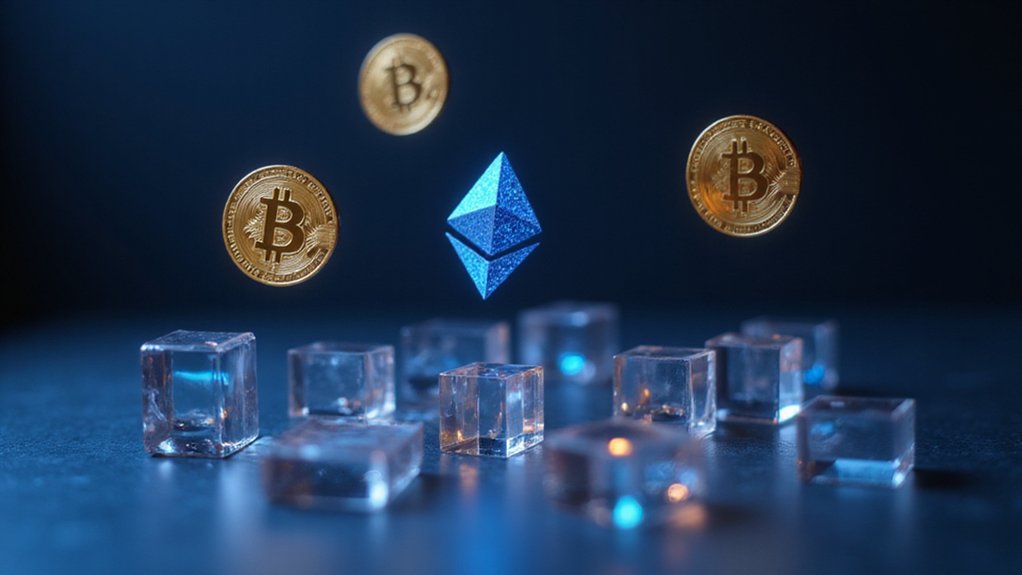Cryptocurrency transactions maintain data integrity through cryptographic protocols that prevent double-spending via mathematical mechanisms rather than institutional promises. Blockchain immutability guarantees network consensus makes altering transactions computationally impractical, while digital signatures using public-private key pairs mathematically prove ownership without revealing sensitive information. Consensus mechanisms like proof-of-work require collective validation before accepting new blocks, operating as digital democracy without central authority. These sophisticated orchestrations reveal additional complexities worth exploring further.

The cornerstone of cryptocurrency’s revolutionary promise lies not in its speculative fervor or the fevered dreams of digital gold rushes, but in something far more prosaic yet infinitely more consequential: the unwavering integrity of data within each transaction. This integrity emerges from a sophisticated orchestration of cryptographic protocols that would make Cold War codebreakers weep with envy—though admittedly, they weren’t concerned with preventing someone from spending the same digital coin twice.
The mathematical certainty of cryptographic protocols proves more trustworthy than centuries of institutional promises—a deliciously ironic triumph of code over human nature.
Blockchain’s immutability serves as the foundation stone, guaranteeing that once a transaction receives network consensus, altering it becomes computationally impractical (barring the deployment of quantum computers or similarly apocalyptic technological developments). The decentralized architecture distributes this responsibility across thousands of nodes, each maintaining identical ledger copies and collectively rejecting any attempt at historical revisionism. This peer-to-peer verification system eliminates the traditional need for trusted intermediaries—a development that has left countless financial institutions scrambling to redefine their relevance.
Digital signatures provide the cryptographic backbone for transaction authenticity, employing public-private key pairs that mathematically prove ownership without revealing sensitive information. When Alice initiates a Bitcoin transfer, her private key generates a unique digital signature that the network can verify using her corresponding public key. This process guarantees that only the legitimate holder can authorize transactions while maintaining transparency across the entire network.
The consensus mechanisms—whether proof-of-work, proof-of-stake, or their various evolutionary offspring—serve as democracy’s digital manifestation, requiring network agreement before accepting new blocks. These algorithms prevent fraudulent transactions through collective validation, creating a system where majority rule governs without central authority. Researchers are actively developing AI/ML-enhanced mechanisms and quantum state-based protocols to address the ongoing challenges of scalability, security, and environmental impact in these consensus systems. However, the raw blockchain data stored in nodes remains in machine-readable format like bytecode, requiring specialized processing to extract meaningful insights for human analysis.
Contemporary challenges emerge primarily from oracle integrity and data origin verification. External data feeding into smart contracts requires additional security layers, with protocols like TLSNotary providing cryptographic proofs of data authenticity. The integration of digital twins and provably honest protocols addresses these vulnerabilities, guaranteeing that real-world data maintains its integrity when crossing into blockchain territory. The persistent issue of human input errors continues to plague blockchain systems, as the technology can only enforce immutability on the data it receives, not correct inaccuracies that occur before consensus.
As regulatory frameworks evolve to accommodate these technologies, the fundamental principle remains unchanged: data integrity in cryptocurrency transactions depends not on trust in institutions, but on mathematical certainty—a proposition that, remarkably, proves more reliable than human nature itself.
Frequently Asked Questions
Can Cryptocurrency Transactions Be Reversed if Data Integrity Is Compromised?
Cryptocurrency transactions remain stubbornly irreversible even when data integrity suffers—blockchain’s immutability guarantees permanence regardless of subsequent discoveries of corruption or manipulation.
While extreme scenarios might theoretically trigger controversial network rollbacks (requiring near-miraculous community consensus), such interventions fundamentally undermine decentralization principles.
The harsh reality? Once confirmed through consensus mechanisms, compromised transactions persist indefinitely, making prevention through rigorous verification processes the only practical defense against integrity failures.
How Do Hardware Wallets Protect Transaction Data From Tampering?
Hardware wallets protect transaction data through cryptographic isolation—private keys never leave the tamper-resistant chip, signing transactions internally before outputting only the signed data.
This architecture prevents malware-infected devices from compromising the signing process, while physical security features detect tampering attempts.
The offline environment guarantees that even sophisticated network-based attacks cannot access or modify the cryptographic operations occurring within the device’s secure enclave.
What Happens When Miners Validate Transactions With Conflicting Data?
When miners encounter conflicting transactions—perhaps two attempts to spend the same Bitcoin—they invoke consensus protocols to determine which version deserves blockchain immortality.
The network basically holds a democratic vote (albeit one weighted by computational power or stake), selecting the legitimate transaction while consigning its conflicting sibling to digital purgatory.
This process prevents double-spending attacks, though temporary network inconsistencies may briefly perplex users until consensus crystallizes around the chosen transaction.
Are Smart Contract Vulnerabilities Considered Data Integrity Issues?
Smart contract vulnerabilities absolutely constitute data integrity issues, though the blockchain community sometimes treats them as separate concerns (a peculiar distinction given their interconnected nature).
Reentrancy attacks, integer overflows, and logic errors directly compromise transaction accuracy and state consistency.
When a smart contract processes incorrect data—whether through missing validation or unchecked external calls—the resulting blockchain entries become permanently flawed, undermining the entire premise of immutable, trustworthy records.
How Quickly Can Blockchain Networks Detect and Respond to Data Attacks?
Blockchain networks demonstrate remarkably swift detection capabilities, processing up to 85,000 samples within two seconds while achieving 98.6% accuracy rates in identifying cyberattacks.
Real-time analytics and collaborative learning models enable immediate threat response, though one might wonder if such impressive statistics translate consistently across all network conditions.
The decentralized architecture facilitates rapid consensus-driven validation, while proactive monitoring tools—assuming they’re properly calibrated—can theoretically intercept attacks before significant damage occurs.









